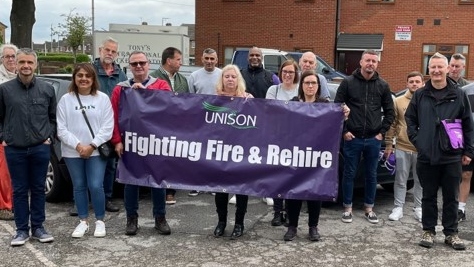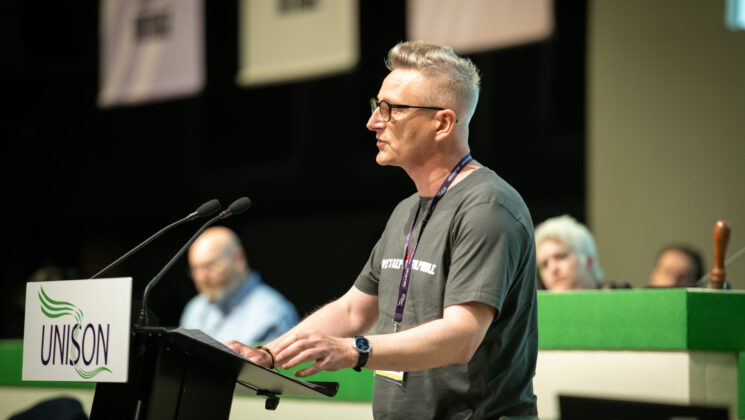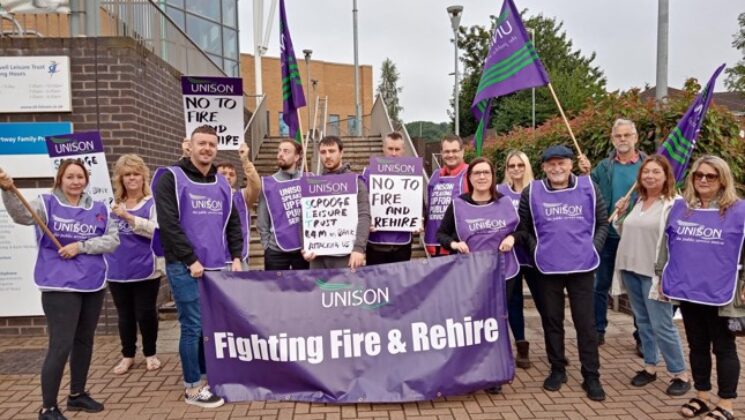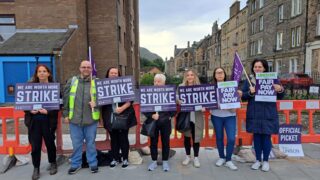Fire and rehire is a hostile employment practice where an employer seeks to terminate workers’ existing contracts and rehire them under new terms.
ACAS classifies fire and rehire as an ‘extreme’ course of action that can seriously damage working relations. However, there are concerns that, as workers feel more vulnerable in the wake of the pandemic, Brexit and the cost-of-living crisis, this ruthless practice is becoming more common.
In January 2021, the TUC found that almost 1 in 10 workers (9%) had been told to reapply for their jobs on worse terms and conditions since the first lockdown in March 2020. Almost twice as many (15%) Black workers have faced fire and rehire compared to white workers.
Is fire and rehire legal?
Fire and rehire is legal, but there are specific redundancy and dismissal practices that the employer must follow. Head of UNISON legal services Shantha David explains: “If an employer wants to make changes to an employee’s contract, and the employee does not agree to these changes, then the employer would need to give contractual notice, normally 3 months, and introduce new contracts. This is done by dismissing and re-engaging staff.”

Shantha David. Image: Ralph Hodgson
Legally, if a fire and rehire proposal relates to 20 or more employees, the employer must comply with a legal duty to “inform and consult” with trade unions. This falls under section 188 of the Trade Union and Labour Relations (Consolidation) Act 1992. If there is no union, or if an employer does not consult with unions, there are consequences.
Shantha explains: “Failure to follow these processes entitles individuals to a financial award of up to 13 weeks gross pay, which would need to be enforced in an Employment Tribunal.”
Ferry company P&O made the news in March this year because they neglected their duty to consult employees, instead dismissing them via pre-recorded video and hiring agency workers on lower wages to replace them.
Shantha says: “P&O decided it was worth flouting the law, and they did this by offering each individual a sum of money equivalent to what they would have got at tribunal in order to push through their changes. It’s a cynical way of doing things.”
However, P&O was not Britain’s first big case of fire and rehire. In 2020, Britain’s biggest energy supplier British Gas threatened to fire and rehire its entire workforce of 20,000 people. UNISON was at the forefront of the fightback.
British Gas: ‘The gloves were off from the start’
During the first COVID-19 lockdown, British Gas workers kept everyone’s homes warm and stoves lit. However, in May 2020, they were told they would have to sign new contracts with reduced conditions, or face redundancy. New contracts proposed increased working hours for no extra pay, reduced premium payments for weekends and bank holidays and fixing wages to market medium pay rates.
National officer for energy Matthew Lay says: “Members were angry and upset. The company wanted to reduce people’s terms and conditions and they chose to do it during COVID-19, probably because they thought it would be more difficult to organise against it, which it was.”
Chair of UNISON British Gas Lindsay McNaught has worked for the company for 25 years. She recalls: “It was absolutely awful. It felt so different to how we’d worked with the company in the past. It wasn’t as if negotiations had broken down and then the employer escalated – negotiations hadn’t even started. The gloves were off from the start.”
In what Matthew describes as a “full-frontal assault”, British Gas simultaneously tried to fire and rehire UNISON too, by serving formal notice of its intention to end recognition agreements with all unions. UNISON represented workers in what’s known as the ‘staff collective’ mostly office-based employees.
“They served notice, effectively meaning that we had to agree to the new collective agreement, or it would cease to exist.”
This meant that, despite having a membership above 50% of the workforce, trade unions would have been forced to enter into a protracted statutory process to regain formal recognition. So UNISON had to both negotiate a new union agreement as well as focus on the battle over workers’ contracts.
Matthew explains: “We set out to row back some of the worst aspects of what they tried to do while simultaneously preparing the ground for an industrial action ballot”
Negotiations were fraught, but using a combination of parliamentary and media pressure, UNISON and the GMB managed to broker a deal with British Gas that covered the workers in the staff collective.
“It was a stressful time. There was a lot at stake, and it was a high profile dispute. But British Gas knew we were deadly serious about industrial action, and we managed to put a lot of pressure on them externally.”
UNISON secured a number of concessions, including a £1000 payment upfront and the introduction of upper market salaries in 2024/25. In the end, both UNISON and GMB staff members voted to accept the package
“What the business did was unnecessary and counterproductive. We could have achieved what we did through negotiation”, says Matthew.
The dispute prompted widespread public condemnation of fire and rehire, with a poll finding that three quarters of the British public would support a ban on the practice.
Regulation or legislation
Though such a ban seems like the most straightforward way to protect workers, the reality is more complicated.
Last October, the government blocked proposed laws to regulate fire and rehire, which would have limited the practice to certain circumstances and possibly more rigorous consultation requirements.
While the Government has promised guidance on the practice of fire and rehire, UNISON does not see the point of this, as statutory provisions currently exist – and clearly fail to deter some employers – and ACAS already offers guidance anyway.
However, regardless of the legal status of fire and rehire, UNISON continues to successfully organise workers to fight back together and secure their jobs.
Sandwell’s victory against fire and rehire
Another key union victory against fire and rehire was won by leisure centre workers in Sandwell in the West Midlands, when a whole workforce of 280 people at Sandwell Leisure Trust was fired and rehired.
After a 20-month campaign, UNISON successfully got everyone’s original contracts restored, and backdated pay for everyone. But it didn’t happen without a fight.
Sandwell branch secretary Tony Barnsley recounts how it began: “The employer mooted the desire to come off NJC pay in 2020 because it didn’t want to pay the 2.75% pay award. They expected the unions to just say ‘okay’. So when we consulted our members and rejected this proposal, they embarked on a fire and rehire process.”
The National Joint Council is the body of trade unions and employers that decide pay for many local and schools workers.
UNISON regional organiser Louise Dalton says: “When an employer wants to fire and rehire people, they don’t use those terms. They just tell everyone they want them to sign new contracts.”
All 280 workers signed the new contracts in order to keep their jobs, then fought to reverse them. Tony describes the strategy: “We combined an industrial action strategy with a political leverage strategy to reverse the fire and rehire. We identified the people with the power to force the employer to back down – Labour councillors – and directly targeted them for 20 long months to persuade them to intervene.”
UNISON was one of three unions representing members at the leisure trust, but the only one to secure a mandate for strike action. Tony puts this down to using famed US organiser Jane MacAlevey’s methods, charting workers and calling individual workers around ballots.
“We were the only union to surpass the turnout,” he says. “The first day of action impacted three of eight centres, and people started joining UNISON just to be part of the action.”

Sandwell workers on strike
Tony describes the impact of the strike: “The leisure trust hated the bad publicity. On the first day’s action, Sandwell Leisure Trust had to take its Facebook page down with messages from the public saying things like ‘you should be ashamed to fire and rehiring staff during the pandemic’.”
Altogether, the workers took seven days of strike action, interspersed with leafleting of the council and individual meetings with councillors. UNISON ended the dispute with more than double the amount of union members, becoming the biggest union, and managed to get the council to terminate the contract with Sandwell Leisure Trust, meaning the chief executive resigned and reversing the fire and rehire.
UNISON secured a backdated pay claim to account for members’ lost earnings through the reduced conditions.
Tony sums up the struggle: “There’s nothing unique about Sandwell, and why Sandwell fought. The methods applied by Jane McAlevey can be applied anywhere, large or small. We charted our members’ activity and voting from the consultative ballot onwards.
“This detailed organising work helped us continue the dispute until we won. Why issue ballot papers and cross your fingers on the turnout when you can apply the organising methods of charting and phone arounds to secure ballot turnouts required?”

Tony Barnsley speaking to UNISON local government conference 2022. Image: Steve Forrest
“With members, you have to keep their confidence by making the industrial action seem a very sensible and logical thing to do. It’s not about being seen to be militant.”
Race to the bottom tactics
UNISON general secretary Christina McAnea says: “Fire and rehire must be considered in the context of the deep imbalances of power within the UK labour market.
“There is a danger that ‘fire and rehire’ style tactics might become widespread, designed to take advantage of the current vulnerability felt by many workers. If more companies pursue such tactics, it will lead to a race to the bottom on pay and conditions of service in the UK economy – at a time when we can least afford it.”
As workers are more vulnerable in the wake of the pandemic, Brexit and the cost-of-living crisis, unions must prepare for this ruthless practice becoming more common.
Nevertheless, though union fire and hire disputes are fraught, UNISON is committed to supporting workers to fight back. Tony Barnsley, grinning over the success at Sandwell, says: “It’s great to win. Not enough activists get to experience the joy of winning disputes. More activists need to learn how to organise and win disputes.”
Find UNISON guidance on:
Bargaining on workforce reorganisation
Bargaining over collective redundancy (including outright dismissal, and dismissal and reengagement on inferior terms)






Well done Unison for keeping our best interests in mind.